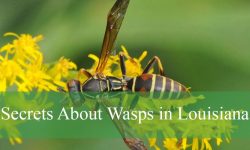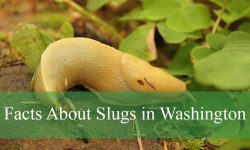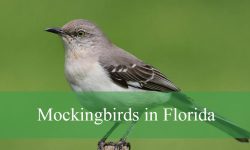Explore 40 fascinating caterpillars with spikes, from stinging hairs to camouflage experts. Learn how to identify these unique caterpillars with stunning pictures and detailed descriptions.
Brief explanation of Caterpillars with spikes
Caterpillars with spikes use these structures for protection, either through chemical defense, camouflage, mimicry, or as a physical deterrent to predators. The specific purpose of the spikes may vary depending on the species and its adaptation to its environment.
Importance of Caterpillars with spikes identification
The identification of caterpillars with spikes is essential for safety, ecological understanding, biodiversity conservation, and pest management, as well as for educational and research purposes. Recognizing these unique caterpillars contributes to the broader understanding of their role in the natural world.
Overview of the 40 Caterpillars with Spikes
1. Gray Buckeye Caterpillar (Junonia grisea)

The Gray Buckeye Caterpillar, also known as Junonia grisea, shares the coloration of its adult counterparts. Its body is primarily brown, gray, and black, adorned with black spikes. This species displays brown, white, and black dorsal stripes and lateral brown spots, maintaining short, pointed, black spikes throughout its entire life.
2. Texas Buck Moth Caterpillar (Hemileuca peigleri)
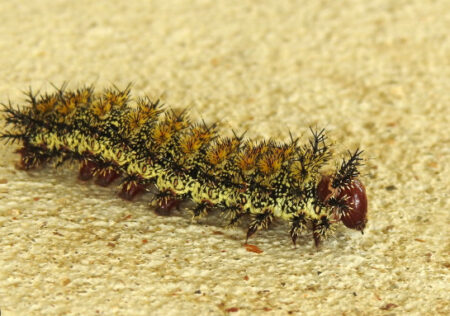
Southern Texas is the feeding ground for the Texas Buck Moth Caterpillar (Hemileuca peigleri), which consumes various types of oak. It stands out thanks to its continuously dark appearance, which includes a black base with brown patches and tall black spikes. Before entering its latter phases of life, its body could at an earlier stage momentarily show a white base color.
3. Hubbard’s Silk Moth Caterpillar (Syssphinx hubbardi)
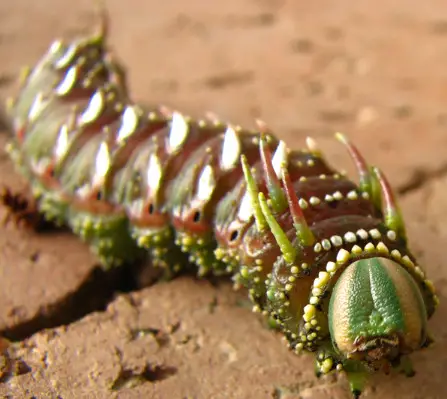
Hubbard’s Silk Moth Caterpillar (Syssphinx hubbardi) is native to the Southern and Southwestern regions, extending to California. It’s characterized by its green body with a variety of multicolored spikes, including green, white, blue, pink, red, yellow, and black. In its final instars, white dots appear on its body, matching the coloration of its green spikes.
4. Spun Glass Slug Moth Caterpillar (Isochaetes beutenmuelleri)

Especially liking swamp oak trees, the Spun Glass Slug Moth Caterpillar (Isochaetes beutenmuelleri) is a frequent pest in Eastern US regions. When it feeds on leaves, its long green spines and green body help it blend in with its surroundings. This caterpillar is not known to induce skin responses when it comes into touch with skin, despite its many green spikes.
5. Columbia Silk Moth Caterpillar (Hyalophora columbia)
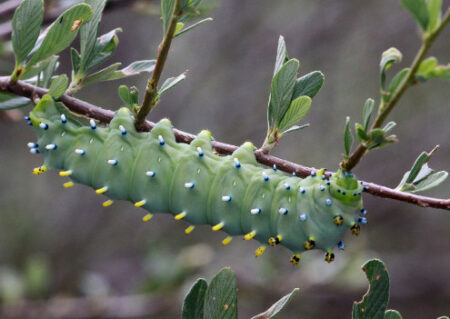
Known for its distinctive look, the Columbia Silk Moth Caterpillar (Hyalophora columbia) is found on Eastern larch and bird cherry trees. Its spikes, which are available in two color combinations—black and green or black and yellow—give it its unique appearance. The caterpillar may have all-yellow spikes on its left dorsal side and blue and black spikes on its right. These caterpillars are completely green in the early stages of life, even the spikes.
6. Calleta Slikmoth Caterpillar (Eupackardia calleta)
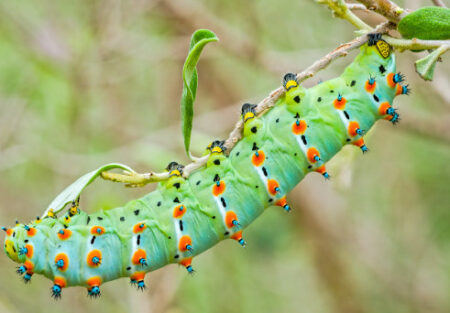
In desert areas of Texas, New Mexico, and California, the Calleta Silkmoth Caterpillar (Eupackardia calleta) mostly eats plants such as purple sage, ocotillo, and wildflowers. As this species ages, its body becomes covered in rainbow spikes, undergoing a color metamorphosis. These spikes can be orange, white, and black in later growth phases, or they can have brilliant bases and black points. In intermediate stages, they can be green and black.
7. Nevada Buck Moth Caterpillar (Hemileuca nevadensis)
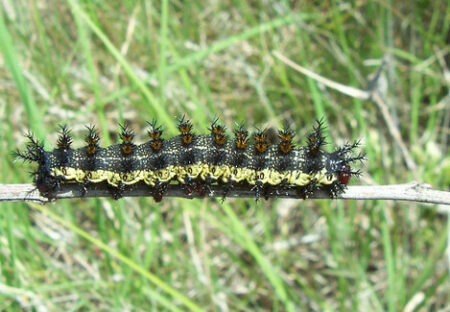
The typical hosts of the Nevada Buck Moth Caterpillar (Hemileuca nevadensis) are cottonwood and willow trees, which are found throughout North American woods. With its distinct body covered with black and yellow stripes and small black spines, this caterpillar is one of the rarest species of black and yellow on the continent. Its spikes are packed together and very short compared to other caterpillars. The scarlet prolegs of the caterpillar create a vibrant contrast with its yellow and black body. When it reaches adulthood, it stops feeding. For the most of its existence, it feeds on the tender sections of the leaves of its host tree.
8. Stinging Rose Caterpillar (Parasa indetermina)
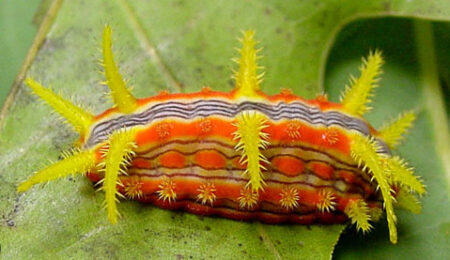
One uncommon and dangerous caterpillar that could endanger people is the stinging rose caterpillar (Parasa indetermina). This species is colorful, showing colors of brown, yellow, and green in its coloring. Thick spikes with shorter colorful spines covering them might break off and pierce the skin, causing skin-level reactions. The venom in these fractured spikes can cause excruciating pain and urticaria. This is one of the most excruciating caterpillar stings in North America, with pain that can last for hours or even days. Orange, green, and yellow are some of the spike hues.
9. Theona Checkerspot Caterpillar (Chlosyne theona)
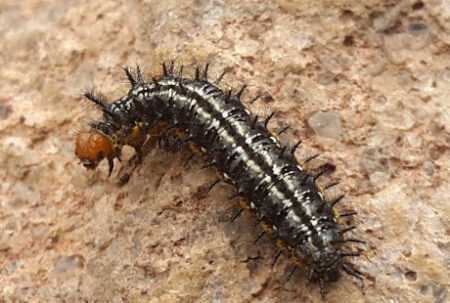
Found throughout the United States, Mexico, and several South American states, the colorful Theona Checkerspot Caterpillar (Chlosyne theona) is a unique species. Later on, it changes from having a light brown body with a dark brown head and lengthy black spikes to having a brown base color with black spikes. It momentarily has a bright brown and white body in middle phases with black spikes that contrast sharply. It only has this dazzling appearance for a few instars until it darkens once more.
10. Crimson Patch Caterpillar (Chlosyne janais)

Typically, acanthus hosts in Texas and Mexico are home to the Crimson Patch Caterpillar (Chlosyne janais). Its distinctive look, which consists of a white body with green overtones and black, banded spikes during its last stages of growth, makes it stand out. Its head is usually dark, but its ventral side and prolegs are yellow-brown in hue. Spikes are black in hue.
11. Saddleback Caterpillars (Acharia stimulea)
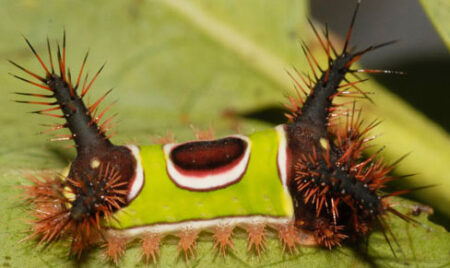
The saddleback when they come into touch with human skin, caterpillars (Acharia stimulea) can be extremely hazardous. Their venom glands are linked to their brown spikes, albeit not everyone reacts severely to them. After unintentional exposure, some people may experience urticaria that lasts for days, while others may just experience minor symptoms like rashes and skin redness. These experiences frequently occur when handling wildflowers like flamingo flowers or climbing their host trees, such as oak or hackberry. Spike colors include brown and brown-black.
12. Io Moth Caterpillar (Automeris io)
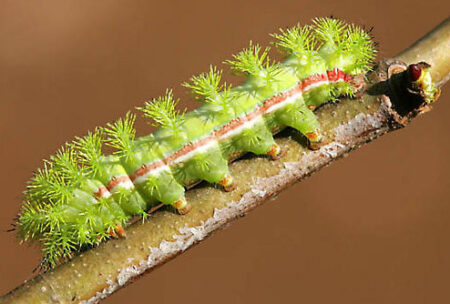
As it matures, the Io Moth Caterpillar (Automeris io) experiences constant color changes in its spikes. This species exhibits notable morphological changes as it develops. In the first instar, it has yellow-orange spikes that turn brown in the second, along with brown body color and yellow stripes with yellow spikes. Later on, it changes to a fully yellow or brown color with corresponding spikes, and in its last stage, it takes on a green body with green spikes and lateral brown and white stripes. Orange, brown, black, yellow, and green are among the colors of spikes.
13. Pine-devil Moth Caterpillar (Citheronia sepulcralis)
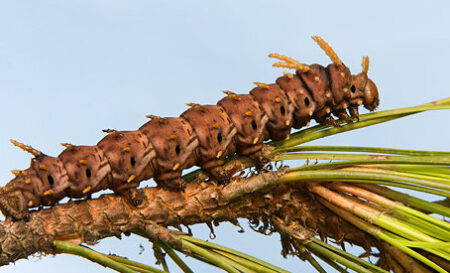
A uncommon species of caterpillar where the spikes match the color of the body is the Pine-devil Moth Caterpillar (Citheronia sepulcralis). Usually dark in appearance, this alpine caterpillar might be gray, brown, or a combination of these. Its spikes and body are both dark in color. Its distinct coloring and larger spikes directly behind the head help it blend in with the pine trees. The hues of spikes are gray and brown.
14. Honey Locust Moth Caterpillar (Syssphinx bicolor)

The Syssphinx bicolor, or honey locust moth caterpillar, exhibits a range of spike colors during its several growth phases. Its base hue is green at first, but as it grows, it may take on several shades. With the exception of the lengthy black spikes behind its head, its first spikes are green, matching the color of its body. The spikes turn a vibrant red or pink-red as it ages, although they stay rather short. The body begins to take on white patches as it grows. The hues black, green, red, pink, and white are examples of spikes.
15. Hickory Horned Devil (Citheronia regalis)
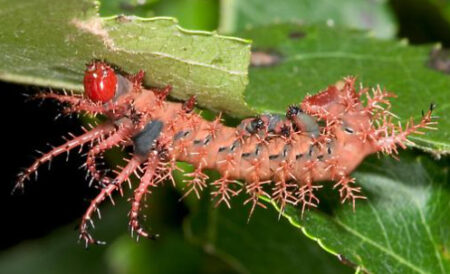
The tree host of the Hickory Horned Devil (Citheronia regalis) gives it its name, and it finally turns green-blue. It looks horned because, in contrast to Cecropia Moth Caterpillars, it has clustered spikes surrounding its head. Apart from the long black spikes behind its head, its dorsal spikes are generally short. It is brilliant green in color and has fewer spikes in the first instar. The colors of spikes include orange, brown, and black.
16. Cecropia Moth Caterpillars (Hyalophora cecropia)
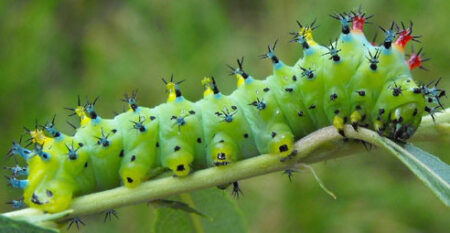
Cecropia Moth Caterpillars (Hyalophora cecropia) have short and colorful spikes that change as they grow. During their initial instar, they have no color. They change to yellow with black spikes in the second stage. In their last instar, they eventually turn green and then green-blue. The small, green, blue, or yellow spikes of this stage are occasionally covered in short, black spikes. Just before the last growth stage, the greatest spikes or tubercles with hues like yellow, blue, black, and orange emerge.
17. Mexican Fritillary Caterpillar (Euptoieta hegesia)
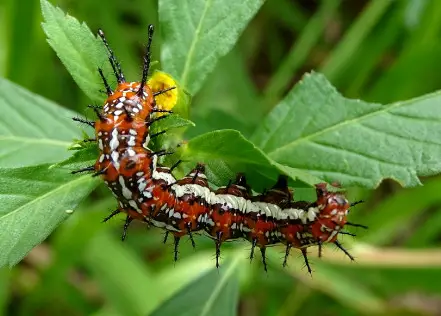
The primary food sources for the Mexican Fritillary Caterpillar (Euptoieta hegesia) are passionflowers and alders. Its base color is brown, and it develops spikes as it matures. Although it is more common in Mexico, Texas is seeing an increase in its presence. It is a dark brown caterpillar in its early stages, with scarcely noticeable yellow-to-brown spikes and white lateral stripes. As it ages, it changes into a brown-red caterpillar with more pronounced black spikes and white stripes. The caterpillar has rows of single lateral spikes and paired dorsal spikes. Yellow and black are the colors of spikes.
18. Variegated Fritillary Caterpillar (Euptoieta claudia)
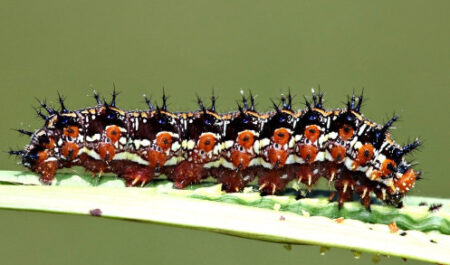
The wildflowers that the Variegated Fritillary Caterpillar (Euptoieta claudia) eats include flax, passionflower, and plantain. These plants are typically found in open spaces and disturbed terrain. It is mostly brown in the early stages, with a few little black spikes. It develops into a brown, black, and white caterpillar with many tiny, thin black spikes on its lateral sides and dorsum as it ages. Spikes have a black color.
19. California Sister Caterpillar (Adelpha californica)

Several caterpillar species prefer oak trees as a food source, and the California Sister Caterpillar (Adelpha californica) is one of them. It has a few spikes and is initially brilliant yellow to white. Twelve dark yellow spikes in pairs along its dorsum are visible as it ages, turning green with yellow spikes before finally settling on a bright green hue with a yellow-white underside. Spike color is yellow.
20. Silvery Checkerspot Caterpillar (Chlosyne nycteis)
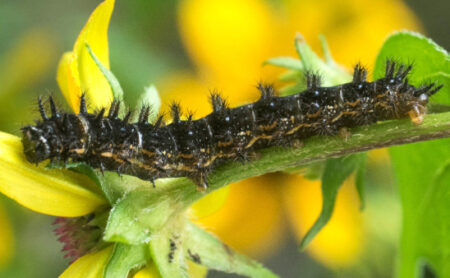
In its first instar, the Silvery Checkerspot Caterpillar (Chlosyne nycteis) is an all-black caterpillar with black spikes, much like the Mylitta Crescent. Later on, it starts to acquire lateral yellow stripes that eventually turn deep brown. It eventually transforms into a brown and black caterpillar with black spiky hair. A few uncommon individuals never change from being black and yellow to brown in their life phases. Spikes have a black color.
21. Mylitta Crescent Caterpillars (Phyciodes mylitta)
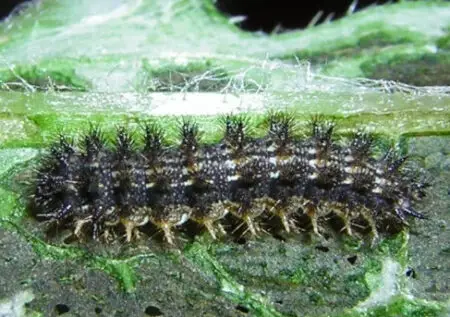
Mylitta Crescent Caterpillars (Phyciodes mylitta) are widespread throughout Western North America, inhabiting various elevations. They can roam freely in search of food in regions where thistles are present, such as Milk thistle. These caterpillars have a characteristic appearance of dark brown and gray, with black spikes arranged in groups on each body segment. The adult Mylitta Crescent butterfly has the same shade of brown-gray. Spikes have a black color.
22. Gray Comma Caterpillar (Polygonia progne)
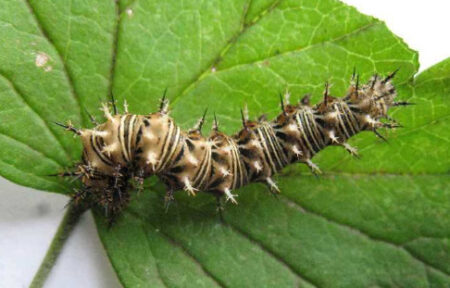
Typically, the Gray Comma Caterpillar (Polygonia progne) consumes azaleas and gooseberries that are located along roadside. It is initially dark crimson, sometimes reddish-brown, with short black spikes. Its spikes, patterns, and colors change as it grows. Later stages include a body with bands that is brown and yellow, with black, dark brown, and yellow spikes. The majority of the spikes in the last instar are yellow, with additional orange-brown or brown dorsal pigmentation. Spike colors include black, yellow, and brown.
23. Question Mark Caterpillar (Polygonia interrogationis)
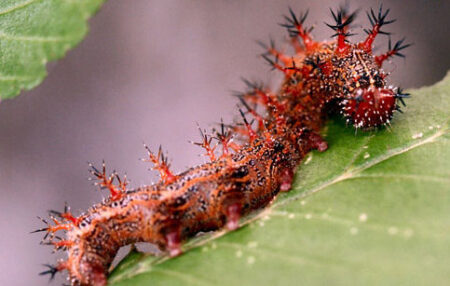
The Question Mark Caterpillar (Polygonia interrogationis) commonly feeds on broadleaf trees like the American elm and hickory. Many spikes and color changes as it grows are characteristics of this species. Its coloring changes from reddish-brown to predominantly black with white patches on its body with time. It keeps the orange-brown spikes throughout the growth phases. It grows into an adult with a black-and-white body covered with yellow spikes, some on the sides and some on the dorsum. Orange-brown and yellow are among the colors of spikes.
24. Mourning Cloaks (Nymphalis antiopa)

There are butterfly species called Mourning Cloaks (Nymphalis antiopa) in North America, Europe, and Asia. Their caterpillars resemble those of other spiky species in appearance. These dark caterpillars, which have a black base color with little white spots and huge brown patches on the mid-dorsum, feed on willow and American elm trees. Their prolegs are the same brown hue as the mid-dorsal patches, and their body is covered in black spikes. They dwell in groups at first, but eventually separate off to seek out more food. Spikes have a black color.
25. Eastern Common Caterpillar (Polygonia comma)
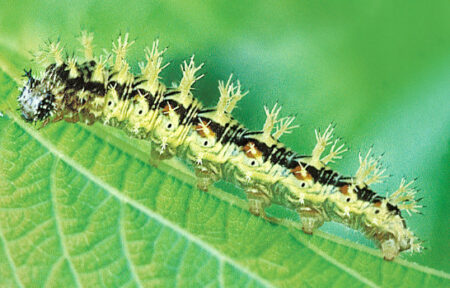
The main food source for Eastern Common Caterpillars (Polygonia comma) is different types of birch. They are initially green but soon turn black, with yellow spikes and lateral bands as they enlarge. This species is distinguished by the striking contrast of black and yellow spines on the caterpillar’s flanks and dorsum. Additionally, certain variations may have red-brown spikes close to the head and brown or reddish-brown ventral pigmentation. Spike hues come in yellow and black.
26. Variable Checkerspot Caterpillar (Euphydryas chalcedona)

The Variable Checkerspot Caterpillar (Euphydryas chalcedona) has a mostly black body, which makes its black spikes somewhat hard to notice. It has a brown center area with white edges surrounding it. Its brown dorsal parts shrink and take on the appearance of dots as it grows, and it may also acquire white or gray bands. The caterpillar maintains its black spikes as it grows. Orange-brown and black are the colors of spikes.
27. West Coast Lady Caterpillar (Vanessa annabella)
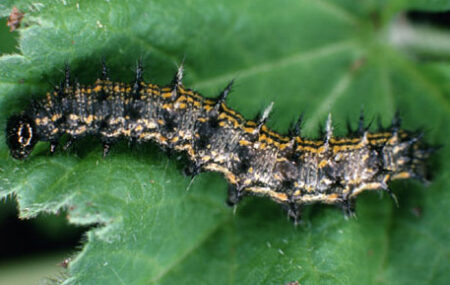
In its early stages, Vanessa Annabella, also known as the West Coast Lady Caterpillar, has a colorful appearance with spikes that match the color of her body. With black spikes and a few yellow spines down its sides, it has a striking black and yellow contrast. Similar to its black and yellow body, the black and yellow spike combination is supposed to ward off predators because yellow is frequently connected to poison by these animals. Spike hues come in yellow and black.
28. Malachite Caterpillar (Siproeta stelenes)

The pipevine swallowtail caterpillar and the Malachite caterpillar (Siproeta stelenes) are similar in appearance. Its body is black, with long orange and brown spikes that are primarily black at the terminals of its slender spines. As the caterpillar gets bigger, these spikes either stay little and orange or develop into spikes that are black at the points and orange at the base. The tips of the caterpillar are hardly visible due to its thin black spikes. Colors of spikes include orange and black.
29. Pipevine Swallowtail Caterpillar (Battus philenor)
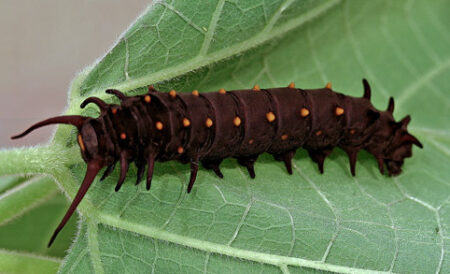
In the eastern and southern United States, pipevines provide food for the Pipevine Swallowtail Caterpillar (Battus philenor). It has bright orange tubercles during the initial instars, which eventually change into long, dark red spines. Longer orange tubercles are seen on the body’s sides, but a few tiny ones are still present on the mid-dorsal region. Orange and red are the hues of spikes.
30. California Tortoiseshell Caterpillar (Nymphalis californica)
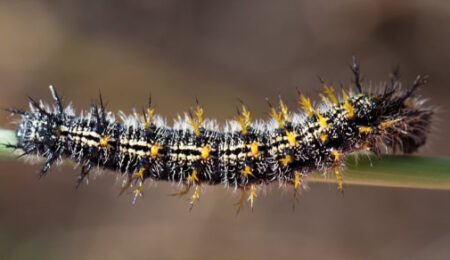
The California Tortoiseshell Caterpillar (Nymphalis californica) is found in the Western US and exclusively feeds on wild lilac. It has a multicolored body that mirrors the adult’s appearance. The caterpillar features a black and brown body, with its brown or orange-brown sections matching the color of its spines. The spikes have dual colors, with black tips and brown bases. California’s chaparral is one of the best places to find this species. Spike colors are black and brown.
31. Zebra Longwing Caterpillars (Heliconius charithonia)
![]()
Zebra Longwing Caterpillars (Heliconius charithonia) exhibit variations in the number and length of their spikes as they grow.
These white caterpillars with brown ventral coloration initially have a few shorter black spines on their dorsum. As the caterpillar ages, it develops more and longer spines, usually two on each segment. Two rows of these black spines are placed, the left row pointing left and the right row pointing right. They consume purple passionflower. Black is the color of the spike.
32. White Peacock Caterpillar (Anartia jatrophae)
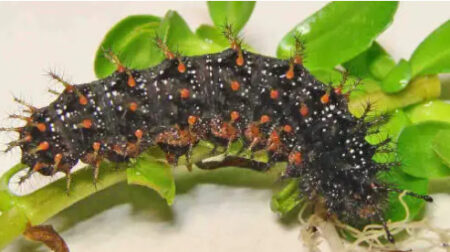
The spiky look of the White Peacock Caterpillar (Anartia jatrophae) is a result of its varied diet of petunias and wildflowers such as Herb-of-grace. This species has a dark body and begins life as a black caterpillar with numerous black spines on its segments. It grows with brown and white dots and stripes at the base of its spines and all over its body. Humans are not at risk from these spines because the caterpillar does not trigger allergic reactions. The colors of spikes are orange and black.
33. Gulf Fritillary Caterpillar (Dione vanillae)
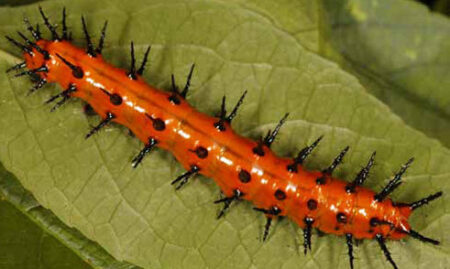
The body of the Gulf Fritillary Caterpillar (Dione vanillae) is striped with dark orange and gray, giving it a spiky look. To ward off predators, its black spines give it a striking and menacing appearance. Its entire body is covered in these black spines, although they are soft to the touch and do not cause harm to human skin. The big spikes on the caterpillar become smaller, sharper-looking but still soft spines as it gets closer to reaching its maximum size. Spikes have a black color.
34. Red Admiral Caterpillar (Vanessa atalanta)
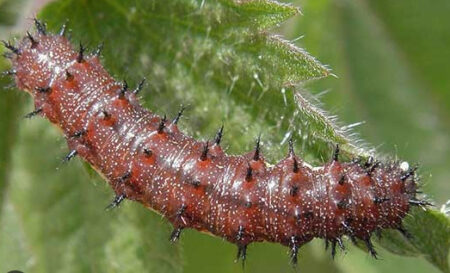
Vanessa atalanta, sometimes known as the Red Admiral Caterpillar, is primarily black in appearance, with an all-black body coated in spines when it is still in its early growth phases. As it ages, it becomes slightly brighter but eventually settles into a dark brown color speckled with tiny white specks. Though smaller than those of other species such as the Great Spangled Fritillary Caterpillar, its spines stay black during all phases of life. The majority of early instar black Red Admiral caterpillars also have white spots on their bodies. Spikes are black in hue.
35. American Lady Caterpillars (Vanessa virginiensis)
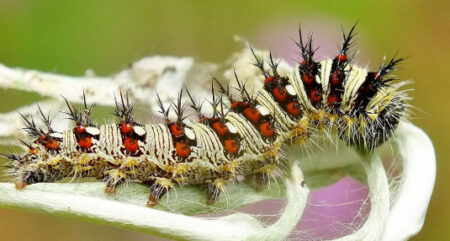
Vanessa virginiensis, often known as the American Lady Caterpillar, is a common plant-eating insect found all over North America. Their striking hues and spikey features define their look. Their body is black with bands of gold gathered together; the black segments or bands have black spikes and white spots. These caterpillars are seen throughout the United States, though their annual distribution in the colder northern states is questionable. The species’ migratory patterns may have a greater impact on its presence in the North than in other places. Spikes have a black color.
36. Common Buckeye Caterpillar (Junonia coenia)
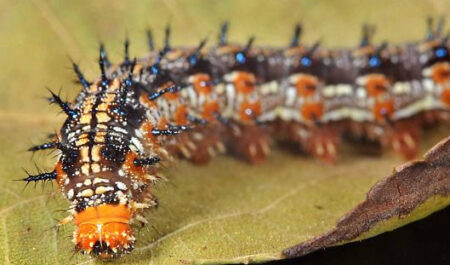
With its black spikes, the Common Buckeye Caterpillar (Junonia coenia) has a gloomy appearance. Each body segment has a different amount of spines growing on it; normally, there are five to seven spikes. Its head also has two spikes. As it grows older, this caterpillar changes color. Its base color is black, but in its early phases, it could also have brown stripes. The caterpillar may have a few white stripes or dots scattered throughout its nearly black appearance. Throughout its growth phases, the caterpillar’s head usually stays brown to black in color.
37. Great Spangled Fritillary (Argynnis cybele)
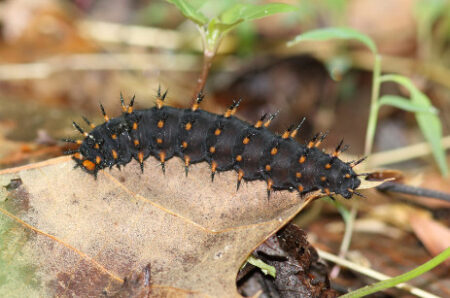
The spiky body of the Great Spangled Fritillary (Argynnis cybele) varies in length and color as it matures. Its base body color is black, with orange and black spines, during its early growth stages, called instars. The black upper regions of the spines feature shorter hair-like growths that mimic spines, while the bottom, orange-brown portions of the spines are spine-like. This caterpillar consumes a variety of violets before changing into a dark brown to black chrysalis and pupating.
38. Luna Moth Caterpillar (Actias luna)
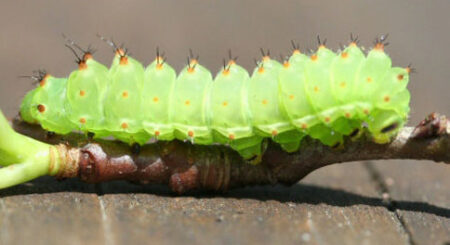
Luna Moth Caterpillars have a series of short, fleshy spikes or tubercles on their bodies, which can sometimes have a slightly bluish tint. These spikes may appear as small, rounded projections. Luna Moth Caterpillars often resemble the leaves of their host trees, which provides them with some level of camouflage and protection from predators.
39. Promethea Moth Caterpillar (Callosamia promethea)
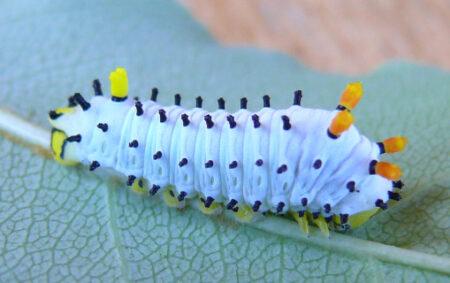
The Promethea Moth Caterpillar (Callosamia promethea) is a distinctive caterpillar native to North America. Promethea Moth Caterpillars feed primarily on the leaves of various tree species, particularly deciduous trees such as sweetgum, tulip tree, spicebush, and wild cherry. They have several small spiky projections or bristles along their body. These spines can be either dark or pale, creating an intricate pattern on their green background.
40. Virginia Ctenucha Caterpillar (Ctenucha virginica)
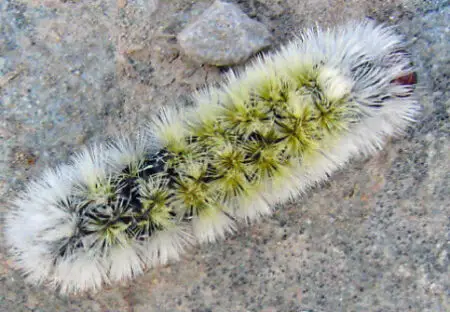
The Virginia Ctenucha Caterpillar (Ctenucha virginica) is a fascinating and visually striking caterpillar species native to the United States. Virginia Ctenucha Caterpillars are easily recognizable due to their vibrant coloration. They have a black body with bright orange bands and a tuft of dense, white hairs on their back, giving them a unique and striking appearance. Virginia Ctenucha Caterpillars are found in a variety of habitats, including open fields, grasslands, and meadows across the eastern and central parts of the United States.
Conclusion
These 40 types of caterpillars with spikes showcase the incredible diversity and adaptations in the insect world. Remember to observe these caterpillars with care, as some may have stinging or venomous spines.
People Who Read This Also Read:


